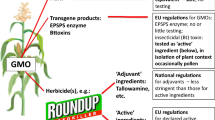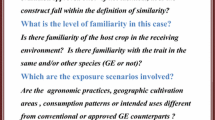Abstract
Risk governance of GM plants and GMfood products is presently subject to heatedscientific and public controversies. Scientistsand representatives of the biotechnologyindustry have dominated debates concerningsafety issues. The public is suspicious withregard to the motives of scientists, companies,and political institutions involved. Thedilemmas posed are nested, embracing valuequestions, scientific uncertainty, andcontextual issues. The obvious lack of data andinsufficient information concerning ecologicaleffects call for application of thePrecautionary Principle (PP). There are,however, divergent opinions among scientistsabout the relevance of putative hazards,definition of potential ``adverse effects,'' andwhether actions should be taken to preventharm. The reliance on the concept ofsubstantial equivalence in safety evaluation ofGM food is equally controversial. Consequently,value assumptions embedded in a scientificframework may be a barrier for employment ofthe PP. One of our major conclusions is thatprecautionary GMP usage requires riskassessment criteria yet undeveloped, as well asbroader and more long-term conceptions of risk,uncertainty, and ignorance. Conflicts ofinterest and public participation are otherissues that need to be taken intoconsideration. GMP governance regimes that arejustifiable from a precautionary and ethicalpoint of view must transcend traditionalscientific boundaries to include alternativescientific perspectives as well as publicinvolvement.
Similar content being viewed by others
REFERENCES
ACRE: Advisory Committee of Release to the Environment, Annual Report No. 2: 1994/1995 (Department of the Environment, London, 1995).
Adler, J. H., “More Sorry than Safe, Assessing the Precautionary Principle and the proposed international Biosafety Protocol,” Texas Int. Law Journal 35 (2000), 173–205.
Aldhouse, P., “Inquiry Blames Missed Warnings for Scale of Britain's BSE Crisis,” Nature 408 (2000), 3–5.
Barrett, K. and C. Raffensperger, “Precautionary Science,” in C. Raffensperger and J. Tickner (eds.), Protecting Public Health and the Environment: Implementing the Precautionary Principle (Island Press, Washington, DC, 1999), pp. 106–122.
Beetham, P. R., P. B. Kipp, X. L. Sawycky, C. J. Arntzen, and G. D. May, “A Tool for Functional Plant Genomics Cause in vivo Gene-Specific Mutations,”Proceedings of the National Academy of Science USA 96 (1999), 8774–8778.
Bergelson, J., C. P. Purrington, and G. Wichmann, “Promiscuity in Transgenic Plants,”Nature 395 (1998), 25.
Buhl-Mortensen, L. and R. Toresen, “Fisheries Management in a Sea of Uncertainty: The Role and Responsibility of Scientists in Attaining a Precautionary Approach,”Int. J. Sustainable Development 4 (2001), 245–264.
Buhl-Mortensen, L. and S. Welin, “The ethics of Doing Policy Relevant Science: The Precautionary Principle and the Significance of Non-Significant Results,” Science and Engineering Ethics 4 (1998), 401–412.
Case Documents: Herbicide Tolerant Oilseed Rape (1994-07-08) (http://www.bion.no.) and notification C/UK/94/M1/1 (http://odin.dep.no/md/engelsk/topics/biodiversity).
CBD: Cartagena Protocol on Biosafety (http://www.biodiv.org/biosafe/protocol,2000).
Clark, E. A. and H. Lehman, “Assessment of GM Crops in Commercial Agriculture,” J. of Agricultural and Environmental Ethics 14(1) (2001), 3–28.
Crawley, M. J., “Bollworms, Genes and Ecologists,” Nature 400 (1999), 501–502.
DeAngelis, C. D., “Conflict of Interest and the Public Trust,” JAMA 284 (2000), 2237–2238.
De Neve, M., S. De Bock, C. De Wilde, H. Van Houdt, I. Strobbe, A. Jacobs, M. Van Montagu, and A. Dipicker, “Gene Silencing Results in Instability of Antibody Production in Transgenic Plants,” Mol. Gen. Genet. 260 (1999), 582–592.
DETR (Department of Environment, Transport and the Regions), Farm-Scale Evaluations of the Impact of the Management of GM Herbicid-Tolerant Oil-Seed Rape and Maize on the Farmland Biodiversity (http://www.environment.detrs.gov.uk/acre/wildlife/index. html, 1999).
Dickson, D., “Scientists Back GM for Third World,” Nature 406 (2000), 115.
Domingo, J. L., “Health Risks of GM Foods: Many Opinions but Few Data,” Science 288 (2000), 1748–1749.
Editorial, “A Sound Approach to GM Debate,” Nature 412 (2001), 569.
EEA: European Environment Agency, Late Lessons from Early Warnings. The Precautionary Principle 1896–2000 (http://reports.eea.eu.int/environmental issue_report_ 2001_22/, 2002).
Ellstrand, N. C., H. C. Prentice, and J. E. Hancock, “Gene Flow and Introgression from Domesticated Plants into Their Wild Relatives,” Ann. Rev. Eco. Systematic 30 (1999), 539–563.
EU: Commission of the European Communities, Communication on the Precautionary Principle (Brussels, 2000) (http://europa.eu.int).
Ewen, S. W. and A. Pusztai, “Effects of Diets Containing Genetically Modified Potatoes Expressing Galanthus nivalis Lectin on Rat Small Intestine,” Lancet 354 (1999), 1353–1354.
FAO: Food and Agricultural Organization/World Health Organization, Biotechnology and Food Safety (FAO, Rome, 1996).
Freestone, D. and E. Hey, “Origins and Development of the Precautionary Principle,” in D. Freestone and E. Hey (eds.), The Precautionary Principle and International Law (Kluwer Law International, Netherlands, 1996), pp. 3–15.
Funtowicz, S. O. and J. R. Ravetz, Uncertainty and Quality in Science for Policy (Kluwer, Dordrecht, 1990) pp. 7–16.
Funtowicz, S. O. and J. R. Ravetz, “Science for the Post Normal Age,” Futures 25 (1993), 739–755.
Garattini, S., “The Risk of Bias from Omitted Research,” BJM 321 (2000), 845–846.
Gasson, M. and D. Burke, “Scientific Perspectives on Regulating the Safety of Genetically Modified Foods,” Nature Reviews 2 (2001), 217–222.
Gebhard, M. and K. Smalla, “Transformation of Acinetobacter sp. Strain BD413 by Transgenic Sugar Beet DNA,” Applied and Environmental Microbiology 64 (1998), 1550–1554.
Gibbons, M., “Science's New Social Contract with Society,” Nature 402 (suppl) (1999), c81–c84.
Gura, T., “The Battlefields of Britain,” Nature 412 (2001), 760–763.
Gurney, S. and J. Sass, “Public Trust Requires Disclosure of Potential Conflicts of Interest,” Nature 413 (2001), 565.
Hansson, S. O., “Adjusting Scientific Practices to the Precautionary Principle,” Hum. Ecol. Risk. Assess. 5 (1999), 909–921.
Ho, M. W., A. Ryan, and J. Cummins, “Hazards of Transgenic Plants Containing the Cauliflower Mosaic Virus Promoter,” Microb. Ecol. Hlth. Dis. 12 (2000), 6–11.
Holmberg, L. and M. Baum, “Work on Your Theories!” Nature Medicine 2 (1996), 844–846.
James, C., Global Review of Commercialized Transgenic Crops: 2000, ISAAA Briefs No. 23 (New York, 2001) (http:// www.isaaa.org).
Kaiser, M., “Fish-Farming and the Precautionary Principle: Context and Values in Environmental Science for Policy,” Foundation of Science 2 (1997), 307–341.
Kuiper, H. A, H. P. J. M. Noteborn, E. J. Kok, and G. A. Kleter, “Safety Aspects of Novel Food,” Food Research International 35 (2002), 267–270.
Lappé M. A., E. B. Bailey, C. Childress, and K. D. R. Setchell, “Alterations in Clinically Important Phytoestrogens in Genetically Modified, Herbicide Tolerant Soybeans,” J. Med. Food 1 (1999), 241–245.
Lemons J., K. S. Shrader-Frechette, and C. Cranor, “The Precautionary Principle; Scientific Uncertainty and Type-I and Type-II Errors,” Foundation of Science 2 (1997), 207–236.
Levidow L., S. Carr, and D. Wield, “Genetically Modified Crops in the European Union: Regulatory Conflicts as Precautionary Opportunities,” J. Risk Research 3 (2000), 189–208.
Losey J. E., L. S. Rayor, and M. E. Carter, “Transgenic Pollen Harm Monarch Larvae,” Nature 399 (1999), 214.
Mikkelsen T. R., B. Andersen, and R. B. Jørgensen, “The Risk of Crop Transgene Spread,” Nature 380 (1996), 31.
Miller, H. I. and G. Conko, “Genetically Modified Fear and the International Regulation of Biotechnology,” in J. Morris (ed.), Rethinking Risk and the Precautionary Principle (Butterworth-Heinemann, Oxford, 2000), pp. 84–104.
Millstone, E., E. Brunner, and S. Mayer, “Beyond Substantial Equivalence,” Nature 401 (1999), 525–526.
Mor T. S., M. A. Gomez-Lim, and K. E. Palmer, “Perspective: Edible Vaccines — a Concept Coming of Age,” Trends Microbiol. 6 (1998), 449–453.
Myhr, A. I. and T. Traavik, “The Precautionary Principle Applied to Deliberate Release of Genetically Modified Organisms (GMOs),” Microb. Ecol. Hlth. Dis. 11 (1999), 65–74.
Myhr, A. I. and T. Traavik, “The Precautionary Principle: Scientific Uncertainty and Omitted Research in the Context of GMO use and Release,” J. of Agricultural and Environmental Ethics 15 (2002), 73–86.
Nielsen, K. M., F. Gebbard, K. Smalla, K. M. Bones, and J. D. van Elsas, “Horizontal Gene Transfer from Transgenic Plants to Terrestrial Bacteria — a Rare Event?” FEMS Microbial. Rev. 22 (1998), 79–103.
Novak, W. K. and A. G. Haslberger, “Substantial Equivalence of Antinutrients and Inherent Plant Toxins in Genetically Modified Foods,” Food and Chemical Toxicol. 38 (2000), 473–483.
OECD, Safety Evaluation of Foods Produced by Modern Biotechnology: Concepts and Orinciples (OECD, Paris, 1993).
Obrycki, J. J., J. E. Losey, O. R. Taylor, and L. C. Jesse, “Transgenic Insecticidal Corn: Beyond Insecticidal Toxicity to Ecological Complexity,” BioScience 51(5) (2001), 353–360.
O'Riordan, T. and A. Jordan, “The Precautionary Principle in Contemporary Environmental Politics,” Environ. Values 4 (1995), 191–212.
Pouteau, S., “Beyond Substantial Equivalence: Ethical Equivalence,” J. of Agricultural and Environmental Ethics 13 (2000), 273–291.
Raffensperger, C. and J. Tickner, “Lessons from Wingspread,” in C. Raffensperger and J. Tickner (eds.), Protecting Public Health and the Environment: Implementing the Precautionary Principle (Island Press, Washington DC, 1999), pp. 349–355.
Ravetz, J. R, “The Science of What If?” Futures 29 (1997), 533–539.
Rio Declaration on Environment and Development, Un.Doc/CoNF.151/5/Rev.1 (1992).
Rissler, J. and M. Mellon, The Ecological Risks of Engineered Crops (MIT Press, Cambridge, Massachusetts, 1996).
Sagar, A., A. Daemmrich, and M. Ashiya, “The Tragedy of the Commoners: Biotechnology and Its Public,” Nature Biotechnology18 (2000), 2–4.
Saxena, D. and G. Stotzky, “Insecticidal Toxin from Bacillus Thuringiensis is Released from Roots of Transgenic Bt Corn in vitro and in situ,” FEMS Microbiology Ecology 33 (2000), 35–39.
Scott, A., A. Stirling, N. Mabey, F. Berkhout, C. Williams, C. Rose, M. Jacobs, R. Grove-White, I. Scoones, and M. Leach, “Precautionary Approach to Risk Assessment,” Nature 402 (1999), 348.
Shelton, A. M. and M. K. Sears, “The Monarch Butterfly Controversy: Scientific Interpretations of a Phenomenon,” The Plant Journal 27(6) (2001), 483–488.
Stanley-Horn, D. E., G. P. Dively, R. L. Hellmich, H. R. Mattila, M. K. Sears, R. Rose, L. C. Jesse, J.. E Losey, J. J. Obrychi, and L. Lewis, “Assessing the Impact of Cry1 Ab-Expressing Cornpollen on Monarch Butterfly Larvae in Field Studies,” Proceedings of the National Academy of Science USA 98 (2001), 11931–11936.
Sutherland, A. R. and W. J. Watkinson, “Policy Making within Ecological Uncertainty: Lessons from Badgers and GM Crops,” Trends in Ecololgy and Evolution 16 (2001), 261–263.
The New Zealand Commision (http://www.gmcommisions.govt.nz/, 2001).
The Royal Society of Canada, Elements of Precaution, Recommendations for the Regulation of Food Biotechnology in Canada (http://www.rsc.ca, 2001).
Traavik, T., “An Orphan in Science: Environmental Risks of Genetically Engineered Vaccines,” Research report for DN. No. 1999-6 (Directorate for Nature Management, Trondheim, 1999).
Trewavas, A. and C. J. Leaver, “Conventional Crops are the Test of GM Prejudice,” Nature 401 (1999), 640.
Watkinson, A. R., R. P. Freckleton, R. A. Robinson, and W. J. Sutherland, “Predictions of Biodiversity Response to Genetically Modified Herbicide-Tolerant Crops,” Science 289 (2000), 1554–1556.
Wolfenbarger, L. L. and P. R. Phifer, “The Ecological Risks and Benefits of Genetically Engineered Plants,” Science 290 (2000), 2088–2093.
Wynne, B., “Creating Public Alienation: Expert Cultures of Risk and Ethics of GMOs,” Science as Culture 10 (2001), 445–481.
Zangerl, A. R., D. McKenna, C. C. Wraight, M. Carroll, P. Ficarello, R. Warner, and M. R. Berenbaum, “Effects of Exposure to Event 176 Bacillus Thuringiensis Corn Pollen on Monarch and Black Swallowtail Caterpillars under Field Conditions,” Proceedings of the National Academy of Science USA 98 (2001), 11931–11936.
Author information
Authors and Affiliations
Rights and permissions
About this article
Cite this article
Myhr, A.I., Traavik, T. Genetically Modified (GM) Crops: Precautionary Science and Conflicts of Interests. Journal of Agricultural and Environmental Ethics 16, 227–247 (2003). https://doi.org/10.1023/A:1023686900879
Issue Date:
DOI: https://doi.org/10.1023/A:1023686900879




